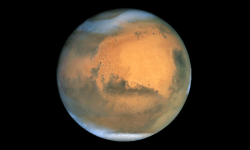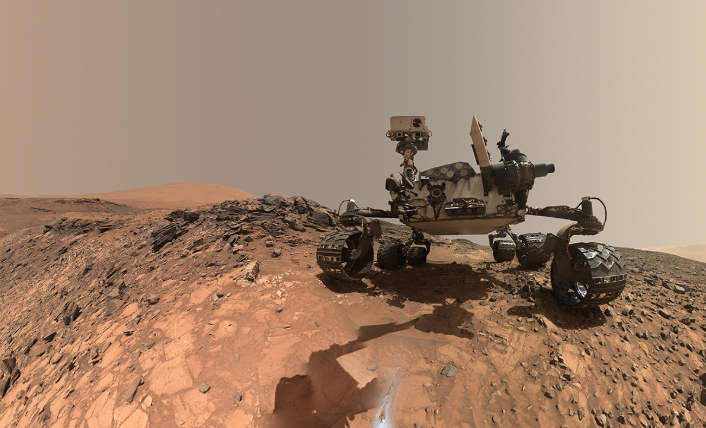
The study of the salinity of Europa’s oceans could tell us if life is possible
– News of June 18, 2019 –
In the late 1990s, the Galileo mission taught us that Europa, one of Jupiter‘s largest moon, is probably home to an ocean of liquid water under its ice crust. Its magnetic field, its almost completely crater-free surface and the detection of geysers are strong evidence in this direction. If it does exist, this ocean is probably salty. To know if it is favorable to life, it is necessary now to determine what is its depth, its salinity and especially of what type of salt it is. A study published on June 12, 2019 focuses on this last question. Salts on the surface of the icy moon have already been detected, including sulphates and salts of sulfuric acid. However, it is not certain that these salts come from the underground ocean.
Europe is in synchronous rotation with Jupiter, that is to say that it always presents the same side. Sulphates have essentially been detected in the hemisphere opposite to its direction of revolution, what might be called the back part of the moon. This detail is important because it suggests that this side could be bombarded with sulfur from the volcanoes of Io, another moon of Jupiter. Sulfuric acid salts would not be a clue to the composition of the ocean. They would have formed by an external contribution.
The best chance to determine the nature of the salts of the inner ocean is therefore to look at the hemisphere on the front side of the moon, much less sensitive to this type of phenomenon. That’s what the team did with the Hubble Space Telescope, and what they discovered is very encouraging. On this side of Europa, there is another type of salt, sodium chloride. It is the salt found in our kitchens, which is also found in significant quantities in the terrestrial oceans.
If the ocean of Europa is salted in the same way as the Atlantic Ocean, the chances of finding life in it are greatly increased. This means, for example, that it can remain liquid at low temperatures. The sodium ions found in table salt are also essential for many terrestrial organisms, whereas when they are in large quantities, sulphates tend to be hostile to life. Of course, we have to confirm this discovery. The sodium chloride observed on this side of Europa could have another source.
Fortunately, the moon of Jupiter is going to be studied a lot over the next decade. In 2023, NASA will launch Europa Clipper, an orbiter almost entirely dedicated to the little moon. The space probe will be equipped with a spectrometer that will confirm the exact location of sodium chloride on the surface of Europa. Ideally, the American space probe will also be able to attend at least one of the geysers of Europa and analyze its composition. If it finds sodium chloride, it will start to become very interesting. This discovery could also be made by Jupiter’s European mission Icy Moons Explorer, which has the same goals but targets a larger number of moons.

Galileo reveals the existence of geysers on Europa, 20 years after its overflight
– News of May 15, 2018 –
Europa is suspected of harboring oceans of liquid water under a thick crust of ice. One of the key points of this hypothesis is the repeated observation of geysers on the surface of this moon of Jupiter. Geysers are a sign of activity in the depths of Europa. To study more closely the chemical composition of these geysers and possibly determine the habitability of Europa, NASA would like one of its space probes to cross these plumes that can climb up to a hundred kilometers of altitude. A spaceship could thus access these hidden oceans without even having to land on the surface of Europa. It is a risky maneuver but could be tempted by a mission like Europa Clipper in a few years.
In fact, this maneuver was probably already done more than twenty years ago by the Galileo spacecraft, but NASA noticed that in 2018. The geysers of Europa were identified for the first time by the telescope Hubble in 2013, but in 1997 when the Galileo mission passed just 124 kilometers from Jupiter’s moon, it recorded a magnetic anomaly that remained unexplained until then. A team of scientists relapsed into the data of the mission which ended in 2003. Two instruments in particular made it possible to draw these conclusions : the magnetometer and the particle detector of the space probe recorded very unusual variations during three minutes. These differences are explained very well if we assume that the space probe has passed through a geyser. The particles emitted by the geyser would have interacted with the magnetic field to give rise to the anomaly.
To test their hypothesis, the scientists modeled the parameters of the mission in a computer simulation and generated a geyser of water vapor when passing close to Europa. The simulation results are in perfect agreement with Galileo’s actual data coupled with flight observations. It is now almost sure that the geysers of Europa exist. However, there are still many questions : are these geysers punctual or permanent, and especially what is their chemical composition ? The Europa Clipper mission and the Jupiter Icy Moon Orbiter mission could provide answers. These two space probes developed respectively by NASA and ESA should be launched at the beginning of the 2020s, and give first results a few years later.
– News of May 23, 2017 –
NASA seems to be eager to send space probes to unravel the mysteries of Europa, Jupiter’s icy moon. Now that it is established that Europa is one of the two places most likely to harbor life in the solar system, we understand why. But what makes the little moon of Jupiter so interesting is its ocean under miles of ice.
NASA has commissioned a team from the University of Arizona to build a seismometer capable of listening to what is happening in the depths of Europa. The ultimate goal of such a probe would obviously be to find traces of life on this moon. But finding traces of life with a seismometer is not easy.
This is where all the ingenuity of NASA teams comes in. By listening to the internal movements of the moon, the scientists of the mission will be able to determine a lot of information including the thickness of the crust of ice, or the forces of the tides due to the proximity of the gas giant Jupiter. But what interests them the most is to discover the lakes in the frozen layer of Europa.
Thus, the channels from which the geysers have been observed on Europa are the privileged targets to go in search of organic traces. They are easy to access because they are relatively close to the surface but still interact with the inner ocean. We already know that there was at least one lake in Europa’s crust, dubbed the Great Lake. But we suspect that there are much more lakes, forming as many different micro-systems. This device could provide the data needed for the mission that really makes dream NASA : a submarine to explore the depths of Europa.
– News of April 18, 2017 –
Hubble’s observations have highlighted the presence of giant geysers on the surface of Europa, up to 100 km altitude. This confirms the strong suspicions of scientists about the presence of a liquid ocean under the frozen surface of the satellite of Jupiter.
We hope that these observations will weigh in the balance on the decision to finance the Europa Clipper mission. This space probe of more than 3 tons which would be launched in the years 2020 and would be entirely dedicated to the study of Europa and its liquid ocean. A mission that could help us answer the question: “Are we alone in the solar system?” Even if Europe has almost no chance of sheltering anything other than a primitive and microscopic life, this discovery would prove to us that the appearance of life on a planet is a rather ordinary phenomenon and not exceptional.
The essentials about Europa (Jupiter’s moon)
Diameter: 3,121 km
Europa is the smallest of Jupiter’s four main moons, but also the most interesting. Its surface of ice seems to be scarified with dark lines while it has few craters, which suggests that there could be under its surface an ocean of liquid water hot enough to shelter life.
Europa has an almost circular orbit and goes around Jupiter in just over 3.5 days. It is in synchronous rotation with Jupiter, so it is always the same side which faces the giant planet.
Dark streaks on the surface of the ice may have been caused by ice cracking and then refreezing, although the surface of Europa is one of the smoothest in the solar system.
Given its potential habitability, Europa is the subject of numerous space mission projects in order to explore its ocean in search of life.









